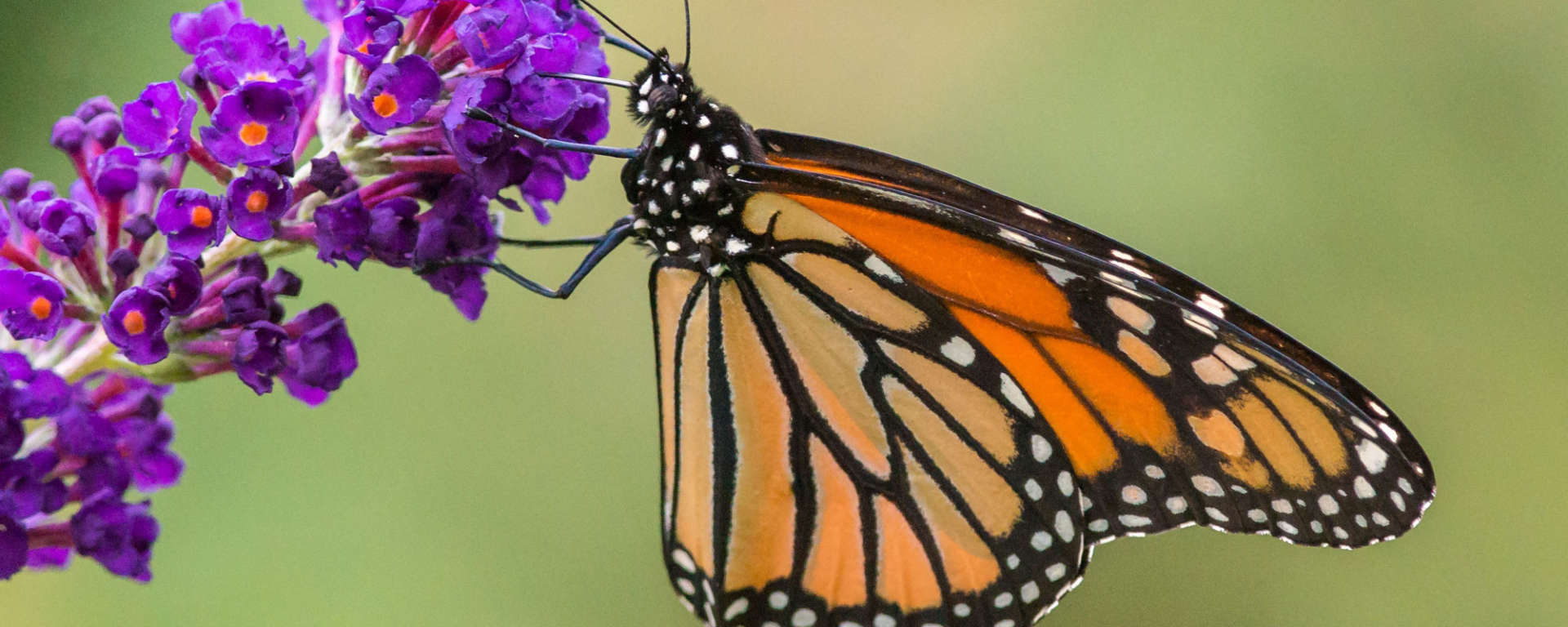The Plight of the Monarch
Posted in: Conservation, News
Safari West’s Monarch Butterfly Program Enters it’s Fourth Season
Safari West, long known for its herds of African mammals and flocks of exotic birds, has a long history of conservation work. Work that often comes in the form of fundraising to protect animals and ecosystems found in far-off lands overseas. What often goes unnoticed, however, are the programs that support the world in our own backyard. One such program supports the once common and always charismatic, monarch butterfly.
The monarch is a large insect with conspicuous black-and-orange wings. Most Americans experience them as they flutter through our neighborhoods during the spring and summer before disappearing again in the fall. As it turns out, when they show up, and how long they stick around, is largely a factor of geography. Depending on where you’re from, you may see them nearly year round, or only for a brief window in time before they move on.
The Amazing Migration
The unusual monarch butterfly migrates through the seasons. During the winter months, they retreat to temperate climes and wait out the harsh weather. West of the Rocky Mountains, these overwintering grounds are found along the California coast, centered along a stretch from Santa Cruz to Pismo Beach. East of the Rocky’s the butterflies travels further south, with the bulk of them winding up in Mexico.
Once warm weather arrives, the butterflies fly north, sipping pollen as they chase the blooms of spring. These monarchs are short-lived and within a handful of weeks, seek out milkweed plants on which to lay their eggs before they die. Several generations will live this way; hatching, migrating, laying, and dying as spring progresses into summer.
At some point, the butterflies will turn back. As summer turns to fall, they flee back to their overwintering grounds where once more, they’ll wait out the winter. Amazingly, the generation that overwinters lives considerably longer than the migratory generations. While the butterflies on the move survive a mere 2-8 weeks, the overwintering butterflies enjoy a full 26-35 weeks (6-8 months) of life!
Monarchs at Safari West
Situated as we are in the Mayacamas Mountains of Sonoma County, Safari West typically begins to see butterflies in early spring. In order to help them out, we’ve planted native milkweed and tasty wildflowers across much of Safari West. Many of the monarchs passing through stop to feast and lay eggs on the abundant milkweed. Once the eggs hatch into little green caterpillars, the head of our butterfly program, “Monarch Merle” Reuser collects them and moves them into our special nursery boxes.
Left to the hazards of life in the wild, fewer than 1-in-10 caterpillars survive to adulthood. Most of them fall victim to starvation, the elements, or even predators (largely invasive species, since the caterpillars are distasteful or even toxic to many native predators). By moving the caterpillars into screened boxes, we can protect them from hungry animals and ensure a steady supply of milkweed. The vast majority of Merle’s monarch caterpillars grow fat, form chrysalises, and emerge as hale and hearty monarch adults. These adults are then released to continue their migration. With any luck, we’ll see their children or grandchildren pass back through in the fall.
A Growing Community
This year, spring came early as far as the monarchs were concerned. For reasons as yet unclear, they began to arrive in our neighborhood in February, a good two months earlier than expected. This earlier start meant the butterflies were arriving in many places before the milkweed supply could support them. The Monarchs Programs Vallejo chapter was hit particularly hard and reached out to Merle for help. As a result, Safari West welcomed 26 transplanted caterpillars who grew up among our own local crop. Of these transplants, a staggering 80% survived to adulthood and fluttered away!
Good News for Monarchs
From the mid-1990’s to 2015, monarch butterfly populations experienced a catastrophic collapse. Whereas nearly 1 billion of them were fluttering over the US in 1995, that number had dropped to some 35 million by 2014. According to Tierra Curry at the Center for Biological Diversity, this “would be like losing every living person in the United States except those in Florida and Ohio.” Thankfully, over the last few years, monarch numbers seem to have recovered somewhat. That “somewhat” is important as the total population remains at a bare fraction of what it was twenty years ago.
The good news is that if you want to help monarchs, you can! Unlike some species, monarch decline appears to be largely the result of one major influence: industrial herbicides. The herbicides we use to keep America’s farmland productive and safe has the unfortunate side effect of decimating the milkweed supply. If you’d like to help the monarch butterfly recover, look no further than your local seed bank.
Find out what type of milkweed is native to your area and plant some in your backyard or garden. While you’re at it, plant some native wildflowers as well. Not only will this beautify your home, it will also provide food and a nursery for the monarchs in your neighborhood. It doesn’t take much to give these charismatic little insects the help they need so please join us in this worthy cause.
P.S.
Merle provides Safari West with routine updates about the monarch butterflies that pass through the preserve. Like the rest of us, these local insects were impacted by the disastrous fires of last fall. Thousands of acres of habitat containing milkweed and wildflowers burned. Although the fires happened in October, monarchs were around, likely passing through the area on their way south. We had a few developing in the nursery boxes at the time the fire broke out. I’m happy to report that the disaster not only spared our staff and nearly 1,000 animals, they spared two beautiful monarch butterflies as well.


